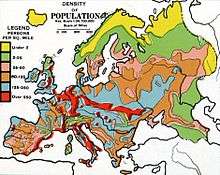Interwar period


In the context of the history of the 20th century, the interwar period[1][2][3] or "interbellum" (Latin: inter-, "between" + bellum, "war") was the period between the end of the First World War (1914–18) and the beginning of the Second World War (1939–45)—the period beginning with the Armistice of 11 November 1918 that concluded the First World War and the ensuing Paris Peace Conference in 1919, and ending in September 1939 with the German invasion of Poland and the start of the World War II.
Description
This period of history was marked by turmoil as Europe struggled to recover from the devastation of the First World War and the destabilising effects of the loss of a number of monarchies, including those of the German, Austro-Hungarian, Russian and Ottoman empires. Later a period of considerable prosperity (the Roaring Twenties) followed, but this changed dramatically with the onset of the Great Depression in 1929. It was during this time that the Weimar Republic in Germany gave way to two episodes of political and economic turmoil, the first culminated in the German hyperinflation of 1923 and the failed Beer Hall Putsch of that same year. The second convulsion, brought on by the worldwide depression, resulted in the rise of Nazism. In Asia, Japan became an ever more assertive power, especially with regard to China.
One main institution intended to bring stability was the League of Nations, created after the First World War with the intention of maintaining world security and peace and encouraging economic growth between member countries. The league was undermined from the start by the non-participation of the United States and the Soviet Union, and subsequently by the bellicosity of Mussolini's Italy, Nazi Germany, and Imperial Japan – leading many to question its legitimacy and effectiveness.
A series of international crises strained the league to its limits, the earliest being the invasion of Manchuria by Japan and the Abyssinian Crisis of 1934-36, in which Italy invaded Ethiopia (Abyssinia), one of the last independent African nations at that time. The league tried to enforce economic sanctions upon Italy, but to no avail. The incident highlighted French and British weaknesses, exemplified by their reluctance to alienate Italy and lose it as their ally. The limited actions taken by the Western powers pushed Mussolini's Italy towards alliance with Hitler's Germany. The Abyssinian war showed Hitler how weak the league was and encouraged his participation in the Spanish Civil War. He also re-militarised the Rhineland in defiance of the Treaty of Versailles. This was the first in a series of provocative acts culminating in the invasion of Poland in September 1939 and the beginning of the Second World War.
There were also other comparably smaller conflicts that major European nations were involved in, such as the Rif War.

See also
References
- ↑ Williamson R. Murray, Allan R. Millett. "Military Innovation in the Interwar Period"
- ↑ Benjamin D. Rhodes. "United States Foreign Policy in the Interwar Period, 1918–1941: The Golden Age of American Diplomatic and Military Complacency"
- ↑ Peter M. R. Stirk. "European unity in context: the interwar period"
Bibliography
- Blythe, Ronald. The age of illusion: England in the twenties and thirties, 1919-1940 (Faber & Faber, 2014).
- Graves, Robert R. and Alan Hodge, The Long Week-End: A Social History of Great Britain 1918-1939 (2001).
- Napper, Lawrence. British Cinema and Middlebrow Culture in the Interwar Years (2010)
- Mowat, Charles. Britain Between the Wars, 1918-1940 (1955), emphasis on politics
![]() Media related to Interwar decades at Wikimedia Commons
Media related to Interwar decades at Wikimedia Commons